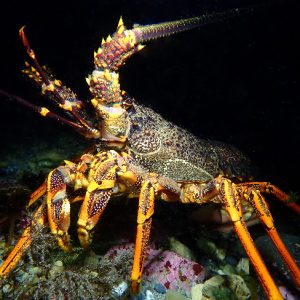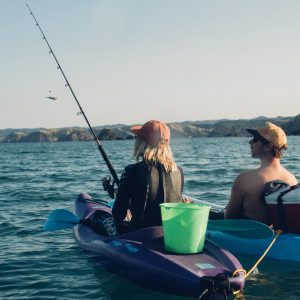Crayfish might not be on everyone’s catch list but they are a treasured meal when shared with family and friends. Not surprisingly they are also a valuable commercial species so when it comes to management there is always high interest in any catch increases.
Management of five crayfish stocks is under review. These stocks extend from Northland to Southland. There are proposals to cut commercial catch levels in two areas, to increase catch levels in another two areas and change the management structure in area 3, around East Cape and Gisborne. Aside from CRA3, all proposals include an option to retain the status quo.
LegaSea strongly objects to the limited timeframe made available to submit, only 18 working days. The submission deadline was on 17th February, but it was not well publicised. Consequently, many people have again missed out on the opportunity to have a say in the future management of this most precious species.

Nathan Guy will soon receive guidance on how he ought to be managing these crayfish stocks in the future. A decision is expected soon and will apply from April 1st this year.
Two new management procedures
A new stock assessment has been completed for crayfish on the east and west coast of Northland (CRA1). It shows a steady increase in biomass (total weight of the stock), from a low point in the mid-1990s to a high in the mid-2000s. Biomass has been relatively constant since then. For the last 20 years the commercial quota has been 131 tonnes per year.
For the first time in CRA1 a management procedure has been developed that uses last year’s commercial catch rate (in kilos per potlift) to set next year’s commercial quota. Depending on which decision rule is used, the quota could stay the same or increase by 6.6 tonnes.
A survey of recreational fishers in 2013-14 estimated the total amateur harvest in CRA1 to be 42 tonnes (± 17%). The report notes that this is probably an underestimate as some cray fishing effort was missed. Allowances for non-commercial fishers will be set for the first time and 50 t is proposed for the recreational allowance and the option of 10 t or 20 t is proposed for the customary allowance
Legasea has some concerns that the high commercial catch rates in recent years have been a result of moving effort to areas (Three Kings and then the Far North) that have previously been lightly fished. If these stocks get fished down effort would quickly shift back to areas close to the main fishing ports.
Both of the proposed rules would allow a 30% decline in the current commercial catch rate before any reduction in quota was made. Surely a more responsive decision rule is needed?
There is also a new stock assessment and decision rule proposed for the East Coast (CRA3). This replaces the old assessment and rule from five years ago. The assessment seems widely optimistic. Estimated spawning stock biomass in 2013 was 70-107% of the unfished level, even though a large part of CRA3 has very few females. The assessment does, however, estimate a steep decline in stock abundance over the next four years, and the decision rule is more conservative than the last. Both rules retain the current quota at 261 tonnes and a 10% drop in catch rate would see a reduction in commercial catch.
Why should I care?
Not so long ago crayfish was one of the most plentiful species found on our rocky coasts. As demand and prices have risen crayfish have been fished heavily in most areas of New Zealand. Our crayfish (red rock lobster) stocks need to be restored to, and managed at, abundant levels. Abundance means there are sufficient numbers and sizes, and a broad age range of crayfish in our marine ecosystem.
Crayfish perform an important role in the marine ecosystem. There is clear scientific evidence that our coastal system has been altered because of the depletion of crayfish. Restoring our marine ecosystem and abundance is vital to ensure fish populations can withstand man-made and natural disasters. It also means fish stocks will be better able to provide for the reasonably foreseeable needs of our children and theirs.
In our view, there is a commercial bias in the management advice given to the Minister from the National Rock Lobster Management Group. Our public interests and wellbeings are largely ignored or passed over with lightweight comments. This creates a sense of disengagement, which is amplified by the short submission timelines given to us by fisheries managers.
LegaSea continues to encourage the Primary Industries Minister, Nathan Guy, to take a more active role in managing and rebuilding our crayfish stocks to levels that do not just meet industry needs but are sufficient to provide for public use.
We need to restore abundance, because doing so will decrease the risks associated with low stock levels, and will better provide for our collective social, economic and cultural wellbeings.
Collapsing fishery?
Last year Nathan Guy, the Minister for Primary Industries, made decisions for the future management of several crayfish stocks including Crayfish 2, between Waipu and the eastern Bay of Plenty. His CRA2 decision confirmed to us that export dollars are more important than rebuilding the fishery, addressing the risks to our marine ecosystem, or satisfying our non-commercial fishing interests.
Our New Zealand Sport Fishing Council-LegaSea submission argued hard for a meaningful cut to commercial quota levels, to enable the stock to double in size from its current low level.
A rebuild was required because both commercial and non-commercial fishers are struggling to find reasonable numbers of crayfish. Also, because boaties are finding it more difficult, by the year, to navigate their way through masses of commercial crayfish pots around some islands, headlands, and reefs.
As the more productive areas are fished out these commercial pots are now appearing in places considered unworthy of fishing, because of low stock numbers, 20 or even 10 years ago. This is having a major impact on available crayfish numbers and affecting recreational access to these popular areas.
It is a race to the bottom, commercial fishers are being driven by the need to take more and more of the catch in the first few years after the crayfish exceeds the minimum legal size. This behaviour increases the exploitation rate, taking younger fish and exposing the stock to more risk.
Guy’s 2014 decision confirmed the CRA2 stock will remain at a very low level because the 15% commercial catch reduction will be inadequate to turn this fishery around from years of overfishing. In fact, such a small reduction in a severely depleted fishery is almost inconsequential.
And, despite the vociferous objections over decades, recreational catch rates continue to decline. The most recent comprehensive survey reveals recreational fishers could only harvest around 30% of the overall recreational allowance.
The annual allowance is 140 tonnes but the harvest survey estimated recreational catch at around 41 tonnes. Even the average size of the crayfish, at 700 grams, would indicate a fishery in trouble.
Another indicator of trouble ought to be that commercial fishers, with all the latest technology, fishing gear, and sonars, cannot catch their current quota limit. We ignore these signals at our peril. Sadly it won’t be us that pays the ultimate price.
It will be our children who face the consequences of any successful change that sees marine reserves, spatial plans or other extreme measures imposed because our fisheries managers failed to act in the best interests of our fish stocks and our community’s wellbeing.
Exclusive club managing our fisheries
In 1992 the National Rock Lobster Management Group was established as a statutory body to provide well informed and credible crayfish management advice to the Minister. More recently it has been variously advertised as a successful multi-stakeholder group, and an example of a functional statutory body.
Our reality is that the Group fails to give advice that enables all sectors to maximise the benefits from our crayfish stocks. Instead, the Group adopts strategies and crafts advice that benefits commercial users, while barely noting the effects of continued low abundance on non-commercial fishers and the marine ecosystem in some areas.
There are many ways our public fishing and environmental interests can be advanced in advice papers, but these are foregone in the pursuit of commercial benefits through higher catches.
LegaSea will continue to expose the management shortcomings and present potential solutions, including several stock rebuilding policies. The New Zealand Sport Fishing Council fisheries management, science and legal teams will continue to strive for application of the purpose and principles of the Fisheries Act 1996.
We, the public, have rights to fish for food and recreation under the Act, as confirmed by the Courts, and failure to properly provide for these rights is unreasonable. The Minister is also legally obliged to sustainably manage fisheries resources to meet the reasonably foreseeable needs of future generations.
Given current management levels Nathan Guy has a long way to go, but we are on standby to help rebuild our fisheries.





